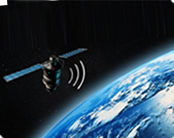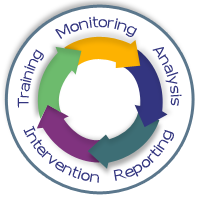Driver and fleet monitoring programs are designed to increase safety on our roadways by providing company owners and / or corporate fleet managers with an ongoing flow of feedback from the driving public. Awareness of such feedback has been proven to be the single most influential factor when it comes to altering driver behaviour, leading to drastic improvements in not only safe, but efficient driving.
Our Driver Reporting Program will help you identify high risk drivers; enabling your company to take a proactive approach of educating, and retraining unsafe drivers before accidents occur that could endanger lives, and cost your organization a loss of time, money, manpower and equipment.
Our tried and true classic yellow decal 1800howsmydriving program has become the North American benchmark for the most effective, yet inexpensive driver safety improvement program that can be implemented in any corporate fleet. With decades of proven results, this is the next best thing to sitting beside the driver in the vehicle yourself.

- PROGRAM
- BENEFITS
- FACTS/MYTHS
Phase 1: Monitoring
Once we receive your registration and vehicle list from your company, we will mail you sequentially numbered decals, which must be affixed to the assigned vehicles.
The decals will read, "How's My Driving?" and will show our toll-free number and website address for motorists to report any comments they may have. Motorists may contact our Safety Call Center 24 hours a day, 365 days a year. All calls are answered "live" by our multi-lingual CSR's and recorded in our digital database. We also provide a web-based reporting system where a motorist can report an observation online thru our website. We also provide an interior decal to remind vehicle operators about the monitoring program.
Next >>Phase 2: Analysis
Our 24-hour Safety Call Center is located in North America and is equipped to take calls immediately upon motorist's call-in. Our Safety Operators are professionally trained to first defuse the motorists' anger, and then document their observations of the incident. All calls are recorded live. These calls are reviewed, and verified by a trained Safety Specialist to eliminate false reports.
<< Prev Next >>Phase 3: Reporting
Your safety manager will deliver the report to you by your preselected reporting method within 15 minutes to 3 hours of the receipt of the call. During high volume or holiday periods the reporting time may increase to a maximum of 24 hours.
Monthly reports will be provided to you by your assigned safety manager.
<< Prev Next >>Phase 4: Intervention
We present you with clear, unbiased and reliable information by way of incident reporting that will allow your company to respond to each situation as it sees fit. Based on our vast monitoring experience we will be able to use baseline data to assist you in indentifying key problem areas for certain drivers that require immediate attention. As your monitoring history increases over time, we are able to map statistics and chart them against comparative industry standards to identify areas of definciency in your transportation operations.
Please visit the Risk Assessment Consulting section for further details on this optional feature
<< Prev Next >>Phase 5: Training
Once we have indentified areas of deficiency, we are able to custom tailor education and training packages that will help correct improper driving behaviour and attitudes.
Please visit the Education / Training section for further details on this optional feature.
<< Prev- Save Lives
Reduces accidents because drivers know they are operating in a supervised environment. Saves driver's jobs and their lives by promoting and recognizing positive driving behaviors. - Proactive Risk Management
Retain employees. Positive recognition for your professional drivers and a reduction in driver turnover cost through the counseling process to modify attitudes and behaviors before they become job/life threatening. - Save Money
Studies by major insurance companies reported: if properly utilized, driver monitoring programs lower accident rates by as much as 53%, which results in insurance premium savings. Reduce your exposure to driver-liability, while significantly cutting administrative cost. - Decrease Liability Exposure
Fleetwatch™ Systems reduces accident and negligence exposure by proactively monitoring company drivers. Pre-employment screening and occasional driver history checks no longer provide adequate protection, but Fleetwatch™ customers are protected by using the most prudent driver risk management system available. - Decrease Administrative Time and Resources
Fleetwatch Systems helps customers save uncountable administrative hours. Since Fleetwatch identifies only those records with new incidents, driver records with no activity are filtered, allowing you to concentrate on those few records that should be reviewed in detail. - Enhance Your Public Image
Shows concern for public safety, letting the driving public know you care when you make it easy to report driving performance. Present a positive Safety Culture image. - Effectiveness
The success of driver monitoring programs is well documented. Even the easily brand recognizable 1800HowsMyDriving.com decal itself provides an additional safety precaution.
This long lasting, micro-prismatic reflective safety material has been proven by *NHTSA to reduce rear end collisions by 30%. If professional truck drivers are able to decrease their accidents and dollars lost by over 50%, imagine the positive impact of this program with your organization's drivers. - Reliability
Receive regularly scheduled monthly reports for proactive monitoring,review,and analysis of your fleet drivers. - Recognition
Our driver monitoring program is duly recognized as the 'leader in driver and fleet monitoring program' in the industry by the *NHTSA (National Highway Traffic Safety Association).
Some Common Myths
- All road observations are negative.
- A driver who receives a negative observation is automatically assumed to be guilty.
- Drivers who receive negative road observations are automatically disciplined and terminated.
- People who call 1-800 numbers just do not like truck drivers.
Goals of this Program
- Influence drivers' behavior on the roadways.Provide the fleet manager with feedback as to how the drivers conduct themselves on the road.
- Provide valuable information on trends and on the effectiveness of vehicle operator's safety practices.
- Openly express your company's concern to the public.
- Save costs to your company by helping to prevent accidents or incidents. The Department of Transportation reports the average cost of a collision involving a tractor/trailer is about $15,000, costing the commercial carrier more than a billion dollars annually.
Collision Expenses
| Expenses of Auto Accident | Cost in $USD |
| Collision Repair | $3000 |
| Replacement Training | $500 |
| Time Lost | $1500 |
| Replacement Labor | $3200 |
| Workmen's Compensation | $1900 |
| Third Party Property Damage | $2600 |
| Third Party Bodily Injury | $2200 |
| TOTAL: | $14900 |
Motorists' Feedback
| Type of Call | Frequency |
| Unsafe Lane Change | 38% |
| Compliments | 16% |
| Speeding | 16% |
| Tailgating | 15% |
| Failure to Yield | 6% |
| Other | 4% |
| Parking | 2% |
| Failure to stop | 1% |
Fleet Watch is recommended by:
National Safety Council
Canadian Safety Council
Keep Our Roads Safe Association
Society of Fleet Supervisors
Mothers Against Drunk Drivers
Risk & Insurance Management Society


































